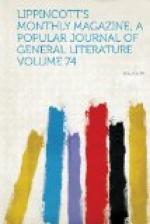The first edition of Cranmer’s Bible, the printing of which was begun in Paris in 1538 and completed in London in 1540—the Inquisition having interposed by imprisoning the printers and burning the greater part of the impression—is excessively rare. Cranmer’s Bible—or the Great Bible, as it was called—is Tyndale’s, Coverdale’s and Rogers’s translations most carefully revised throughout. This was the first sound and authorized English version; and as soon as it was perfected a proclamation was issued ordering it to be provided for every parish church, under a penalty of forty shillings a month. A second edition of Cranmer’s Bible appeared in 1560, a copy of which brought, at a recent sale in England, the sum of $610.
The Genevan version of the Bible was made by several English exiles at Geneva in Queen Mary’s reign—viz., Cole, Coverdale, Gilby, Knox, Sampson, Whittingham and Woodman—and was first printed in 1560. It went through fifty editions in the course of thirty years. This translation was very popular with the Puritan party. In this version the first division into verses was made. It is commonly known as the “Breeches Bible,” from the peculiar rendering of Genesis iii. 7—” breeches of fig-leaves.” To the Geneva Bible we owe the beautiful phraseology of the admired passage in Jeremiah viii. 22. Coverdale, Matthew and Taverner render it, “For there is no more treacle at Gilead?” Cranmer, “Is there no treason at Gilead?” The Genevan first gave the poetic rendering, “Is there no balm in Gilead?”
In the year 1568 another translation appeared, which is indiscriminately known as “Matthew Parker’s Bible,” the “Bishops’ Bible” and the “Great English Bible.” This version was undertaken and carried on under the inspection of Matthew Parker, second Protestant archbishop of Canterbury. Of the fifteen translators, six were bishops, hence this edition is often called the Bishops’ Bible, though it is sometimes designated the Great English Bible, from its being a huge folio volume. In 1569 it was published in octavo form. There is a well-preserved copy of the first edition of Matthew Parker’s Bible in the possession of a gentleman residing in New York City. This was the authorized version of the Scriptures for forty years, when it was superseded by our present English Bible.
The English Roman Catholic College at Rheims issued in the year 1582 a translation of the New Testament, known as the “Rhemish New Testament.” It was condemned by the queen of England, and copies imported into that country were seized and destroyed. In 1609 the first volume of the Old Testament, and in the following year the second volume, were published at Douay, hence ever since known as the Douay Bible. Some years since Cardinal Wiseman remarked that the names Rhemish and Douay, as applied to the current editions, are absolute misnomers. The publishers of the edition chiefly used in this country state that it is translated from the Latin Vulgate, “being the edition published by the English College at Rheims A.D. 1582, and at Douay in 1609, as revised and corrected in 1750, according to the Clementine edition of the Scriptures, by the Rt. Rev. Richard Challoner, bishop of Debra, with his annotations for clearing up the principal difficulties of Holy Writ.”




